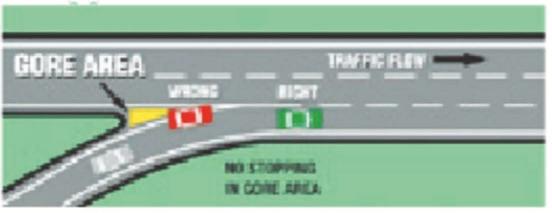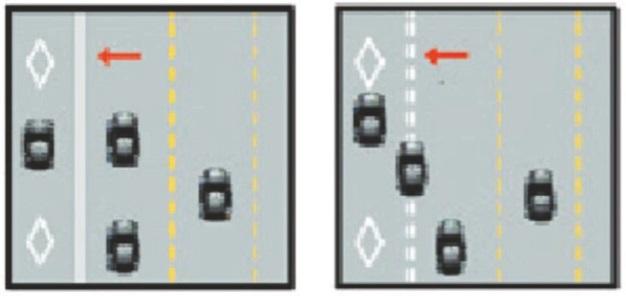
Section 8 Continued: More Safety Guidelines pt2
Expressway Driving
An expressway differs from normal roads or highways in that access to it is controlled. Vehicles can only enter and exit the expressway at specific places known as interchanges. Most expressways in Georgia are free, but there are a few that require a toll.
With the exception of the controlled enter/exit points and HOV lanes, expressways are similar to traveling on a divided highway. There is a median separating traffic traveling in opposite directions; lanes are marked with dashed lines, and the edge of the roadway is marked with a solid line; slower traffic should keep to the right; and all traffic laws and guidelines associated with safe driving still apply.
Entering Expressways
The entrance ramp is a short one-way road that leads to the expressway. From the entrance ramp, you should move into the acceleration lane. This is the lane that runs alongside the main roadway. In the acceleration lane, you can adjust your speed to the speed of the expressway traffic. When safe to do so, you should merge into traffic. Vehicles on the expressway have the right of way, but courteous drivers will permit you to move into the expressway traffic.
Exiting Expressways
Prepare to exit a controlled access highway by safely moving to the right lane for an exit on the right, or the left lane for an exit on the left. Guide signs will tell you of the approaching exit. At the exit, deceleration lanes are provided for slowing down when leaving the expressway. Posted exit speeds are usually low due to the design of the roadway. Drivers should use either brake lights or a turn signal to indicate a change in speed to the drivers behind if slowing down in the traveling lane when preparing to exit.
Use of Lanes on Expressways
Drivers operating vehicles on divided highways must drive to the right of the median unless directed to do otherwise by a sign, traffic control device, or police officer. Drivers must obey the yellow or white striping on the roadway that indicates lanes, the convergence of lanes, or areas in which vehicles should not operate. Drivers may only access or exit controlled-access roadways at designated entrances and exits.
Gores

The term "gore" means the area of convergence between two lanes of traffic. The gore is the area, usually similar to a triangle, formed by solid white lines between an existing lane of travel and a merging lane of travel. Gores are most often seen at the convergence of an acceleration lane and the adjacent travel lane on a controlled access highway. The gore is the area bounded by solid white lines between the acceleration lane and the adjacent travel lane. Drivers entering the controlled access highway are prohibited by law from crossing this solid white line, and are required to continue traveling in the acceleration lane until the solid white line disappears.
HOV Lanes

High Occupancy Vehicle (HOV) lanes are travel lanes that are restricted to vehicles with more than one occupant, buses, motorcycles, and vehicles with Alternative Fuel Vehicle license plates. The lanes are marked with a diamond symbol and the hours of restriction are posted. The penalty for violating HOV lane restrictions is a fine up to $75 for a first offense; up to $100 for a second offense; up to $150 for a third offense; and up to $150 plus one point added to the violator's driving record for a fourth or subsequent offense.
HOT Lanes
High Occupancy Toll (HOT) lanes are I-85 Express Lanes that allow registered transit, three or more person carpool, motorcycles, emergency vehicles, and Alternative Fuel Vehicles to use the lanes toll-free.
Tips For Expressway Driving
- Plan your trip carefully. Mark the map to indicate all entrances, service areas, and exits you plan to use. Doing these things will help you to have a safe, fast, and pleasant journey. You can check the GDOT 511 website for road construction, road closures, exit numbers, and other information to help plan your trip;
- Check your car before you start. Because expressways are designed for faster and smoother flowing traffic, there are fewer places to exit. It is important to check your gasoline gauge and make sure you have enough fuel. Also check the water, oil,and tires of your vehicle;
- Be alert. Use your rear view mirror and side mirror to constantly check the traffic around you. Always make visual traffic checks before you change lanes;
- Stay out of another driver's blind spot. Traveling in a position where the driver ahead of you cannot observe your vehicle in the rear view or side mirrors is a dangerous practice; the driver might pull out in front of you to pass a car. Either stay far enough behind so that the other driver can see you, or pass the vehicle. This is especially true for driving near large vehicles. Tractor-trailer combinations, also known as "eighteen-wheelers", are limited in their visibility because of their size;
- Use turn signals. Be sure to activate your right or left turn signal to indicate that you are changing lanes BEFORE you begin the maneuver;
- Allow plenty of room when passing. Returning to your lane of travel before you have passed another vehicle and provided enough safe distance between the two can cause a crash. Carefully check the left lane behind you before pulling out to pass. Don't pull back into the right-hand lane until you can see the car that you just passed clearly in your rear view mirror;
- Always obey the posted maximum and minimum speed limits. These laws exist to regulate the flow of traffic and to create a safe environment for all drivers;
- In metro areas, expressways will usually have a dramatically increased amount of traffic during the hours that most drivers are traveling to and from their places of employment. The number of cars on the expressway during this time will lead to delays. During this time, drivers should be particularly cautious. Driving defensively, allowing a safe distance between vehicles, and obeying all traffic control signs and devices can help ensure a safe commute;
- Don't back up. Driving in reverse on an expressway is prohibited under any circumstances;
- Stopping on the expressway is prohibited. You will find rest areas and service signs at frequent intervals; use them. Stopping on the roadway shoulder is highly dangerous and permitted only in an emergency. Switching drivers, stretching, or retrieving an item from the back of the vehicle is NOT considered an emergency. If it is necessary to stop, raise the hood and activate your hazard lights to indicate difficulty. Don't walk along the expressway in search of help;
- Drowsiness and fatigue is a danger anytime you drive, but is especially dangerous on long trips along the expressway. Stop driving if you feel drowsy. Don't rely on stimulant drugs (also called Stay Awake Drugs). They are likely to make your driving even more hazardous. Expressway drivers are subject to "highway hypnosis," a condition of drowsiness or unawareness brought on by monotony, the sound of the wind, the tires on the pavement, and the steady hum of the engine. On long trips it is a good idea to "exercise your eyes" to help keep you alert. Keep shifting your eyes from one area of the roadway to another and focus on various objects, both near and far, left and right. Conversation with other passengers and lively radio programs may also help you remain more alert. Of course,always pay attention to the traffic around you and potentially hazardous highway conditions;
- Drive defensively. The key to defensive driving is awareness. You must keep your eyes moving so that you can keep track of what is happening around you at all times. Avoid staring at the center line on the roadway. Instead, look ahead for trouble spots which may endanger you or your passengers. A defensive driver will also frequently check the rear view and side mirrors to keep abreast of the traffic and road conditions to the rear and sides;
- Never trust other drivers to do what you think they are going to do or what you think they should do in a particular situation. The fact that a left turn signal is flashing does not necessarily mean that the driver is going to make a left turn. You should constantly be thinking of an "escape route" as you drive. For example, if you are approaching a curve, you should be looking closely at the shoulder and nearby area to determine what you would do if a car approaching from the other direction crosses to your side of the road. After a little practice this will become more instinctive.
Other Highway Emergencies
| Fire | Accelerator Jammed | Brakes Fail | Wet Brakes |
|---|---|---|---|
|
|
|
|
Protecting the Air
The operation of motor vehicles has a significant impact on Georgia's air quality. Emissions from cars and light duty trucks contribute to the formation of ground-level ozone, a component of urban smog. Vehicle emissions can react with sunlight at high temperatures to produce unhealthy levels of this form of air pollution. This is especially true during warm weather. Vehicle emissions and ground-level ozone can be reduced by proper vehicle maintenance in accordance with the manufacturer's instructions, and by fewer trips and vehicle miles traveled.
In the thirteen-county metro Atlanta area, gasoline-powered cars and light-duty trucks that are less than 25 model years old must pass an emissions inspection every year prior to registering their vehicle with the county of residence (the most recent three model years are exempt from this requirement). The thirteen metro counties covered by the state's inspection and maintenance program are: Cherokee, Clayton, Cobb, Coweta, DeKalb, Douglas, Fayette, Forsyth, Fulton, Gwinnett, Henry, Paulding and Rockdale. For more detailed information about the emissions inspection program, call the Georgia Clean Air Force at 1-800-449-2471. Remember removing or disabling a vehicle's emissions control components is a violation of federal and state law.
In addition to proper vehicle maintenance, you can help reduce air pollution and traffic congestion by limiting driving to necessary travel, by planning ahead to consolidate trips, and by using carpools, transit and ridesharing. All drivers should do their part to reduce the impact of automobiles and trucks on air quality and the environment.
Idling Engines
Minimize your idling time. Eliminating unnecessary idling can reduce fuel consumption, engine wear and air pollution. When warming up the engine, follow the manufacturer's guidelines to assure sufficient engine performance for safe driving. Idling a vehicle for 10 seconds will consume more fuel than restarting the engine.
For more information on emissions testing regulations & protecting Georgia's air quality: